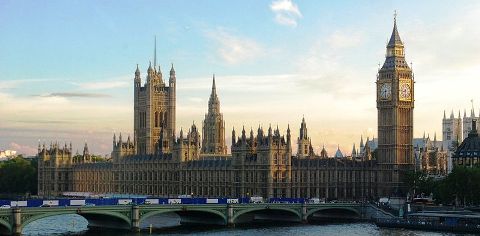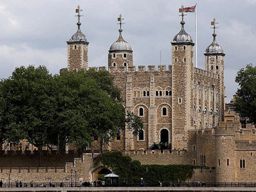United Kingdom: Facts and Interesting Information
United Kingdom Fact File
Location: The United Kingdom (UK) is located to the north-west of continental Europe. The UK is made up of the island of Great Britain (including England, Scotland and Wales), and part of the island of Ireland – the area called Northern Ireland. Northern Ireland has a border with the Republic of Ireland, but apart from this, the rest of the UK is surrounded by water (the Atlantic Ocean, the North Sea, the Irish Sea and the English Channel.Capital: London (also the UK’s largest city)
Population: 63 million (approx)
Area: 243,610 km sq
Currency: Pound Sterling
Official Language: English
The Flag of the United Kingdom

Often called the Union Jack or Union Flag, the flag of the United Kingdom combines the flags of the the patron saints of England, Ireland and Scotland -the red cross of Saint George, the Cross of St Patrick and the St Andrew’s Cross (the Saltire). Wales is not represented in the flag because when the flag design was put together, Wales was part of England.

Other Facts About The United Kingdom
- The United Kingdom is described as a set of countries (England, Scotland, Wales and Northern Ireland) within a country (United Kingdom). To add to the confusion, the term Britain is often used instead of United Kingdom. Strictly speaking, Britain (short for Great Britain) should only be used to describe the island of Great Britain (England, Wales and Scotland). Click here to learn more about the differences between the terms United Kingdom, British Isles, Great Britain and England.
- The official name of the United Kingdom is the United Kingdom of Great Britain and Northern Ireland.
- The people who live in the UK are referred to as British.
- People have been living in the UK for about 30 thousand years. It has been the home of the Celts, the Picts, the Romans, the Anglo-Saxons, the Vikings, and the Normans.
- The UK fought against Germany in both World War 1 and World War 2.
- The Channel Tunnel connects the UK to France. It is the world’s longest underground tunnel (38 km underwater).
- The Channel Islands (Jersey and Guernsey) and the Isle of Man do not form part of the United Kingdom.
- The Summer Olympic Games have been held in London on three occasions: 1908, 1948 and 2012. The United Kingdom team is referred to as Team GB.
- England
- Wales
- Scotland
- Northern Ireland
Watch this video before you go on to the section below.
Geography of United Kingdom
Borders: Republic of Ireland (only land border), Atlantic Ocean, North Sea, English Channel, maritime (water) borders with France, the Netherlands, Belgium, Denmark, Norway, Iceland, and Spain
Size Comparison: slightly smaller than Oregon
Geographical Coordinates: 54 00 N, 2 00 W
World Region or Continent: Europe
General Terrain: mostly rugged hills and low mountains; level to rolling plains in east and southeast
Geographical Low Point: The Fens -4 m
Geographical High Point: Ben Nevis 1,343 m
Climate: temperate; moderated by prevailing southwest winds over the North Atlantic Current; more than one-half of the days are overcast
Major Cities: LONDON (capital) 8.615 million; Birmingham 2.296 million; Manchester 2.247 million; West Yorkshire 1.541 million; Glasgow 1.166 million (2009)
Major Landforms: Island of Great Britain, Island of Ireland (northern fifth), Cumbrian Mountains, Pennines, Hebrides Islands, Shetland Islands, Scottish Highlands, Ben Nevis, Highland Boundary Fault, Mourne Mountains
Major Bodies of Water: Thames River, Severn River, Humber River, Lough Neagh (lake), Loch Lomond, Windermere, Bala Lake, English Channel, North Sea, Irish Sea, Celtic Sea, Atlantic Ocean
Famous Places: Tower of London, Buckingham Palace, Stonehenge, Westminster Palace, Big Ben, London Eye, Windsor Castle, Trafalgar Square, Cotswolds, St. Paul's Cathedral, Tower Bridge, Hyde Park, Loch Ness, Wembley Stadium, Ben Nevis, Globe Theatre, Edinburgh Castle, White Cliffs of Dover, Channel Tunnel

Palace of Westminster
Economy of United Kingdom
Major Industries: machine tools, electric power equipment, automation equipment, railroad equipment, shipbuilding, aircraft, motor vehicles and parts, electronics and communications equipment, metals, chemicals, coal, petroleum, paper and paper products, food processing, textiles, clothing, other consumer goodsAgricultural Products: cereals, oilseed, potatoes, vegetables; cattle, sheep, poultry; fish
Natural Resources: coal, petroleum, natural gas, iron ore, lead, zinc, gold, tin, limestone, salt, clay, chalk, gypsum, potash, silica sand, slate, arable land
Major Exports: manufactured goods, fuels, chemicals; food, beverages, tobacco
Major Imports: manufactured goods, machinery, fuels; foodstuffs
Currency: British pound (GBP)
National GDP: $2,288,000,000,000
Government of United Kingdom
Type of Government: constitutional monarchyIndependence: England has existed as a unified entity since the 10th century; the union between England and Wales, begun in 1284 with the Statute of Rhuddlan, was not formalized until 1536 with an Act of Union; in another Act of Union in 1707, England and Scotland agreed to permanently join as Great Britain; the legislative union of Great Britain and Ireland was implemented in 1801, with the adoption of the name the United Kingdom of Great Britain and Ireland; the Anglo-Irish treaty of 1921 formalized a partition of Ireland; six northern Irish counties remained part of the United Kingdom as Northern Ireland and the current name of the country, the United Kingdom of Great Britain and Northern Ireland, was adopted in 1927.
Divisions: The United Kingdom consists of four countries: England, Scotland, Wales, and Northern Ireland. Each country has its own way of forming administrative divisions of the government. England is divided up into nine regions, Scotland into 32 council areas, Wales into 22 authorities, and Northern Ireland into 26 districts.

Tower of London
- North East
- North West
- Yorkshire and the Humber
- East Midlands
- West Midlands
- East of England
- London
- South East
- South West
National Symbols:
- Animal - Bulldog (England), Lion
- Bird - Red Kite (Wales)
- Flower - Tudor Rose (England), Thistle (Scotland), Flax Flower (Northern Ireland)
- Tree - Royal Oak
- Colors - Red, white, and blue
- Motto - "God and my Right", "In Defense" (Scotland)
- Other symbols - Unicorn (Scotland), Welsh Dragon (Wales), Britannia

Other flags:
- England - White with a red cross.
- Scotland - Blue with a white "x".
- Wales - Two horizontal stripes of white (top) and green (bottom) with a red dragon.

Flag of Scotland
Other Holidays: New Years' Day (January 1), Saint Patrick's Day (March 17), Easter, May Day (May 1), Bank Holiday, Christmas (December 25), Boxing Day (December 26)
The People of United Kingdom
Languages Spoken: English, Welsh (about 26% of the population of Wales), Scottish form of Gaelic (about 60,000 in Scotland)Nationality: Briton(s), British (collective plural)
Religions: Christian (Anglican, Roman Catholic, Presbyterian, Methodist) 71.6%, Muslim 2.7%, Hindu 1%, other 1.6%, unspecified or none 23.1% (2001 census)
Origen of the name United Kingdom: The name "United Kingdom" is short for the official name of the country which is the "United Kingdom of Great Britain and Northern Ireland." The term "Great Britain" is used to describe the island that contains the three countries England, Scotland, and Wales. When Ireland was added, the country became known as the United Kingdom.
Famous People:
- David Beckham - Soccer player
- Winston Churchill - Prime Minister during World War II
- Captain James Cook - Explorer
- Princess Diana - Famous Princess
- Sir Francis Drake - Explorer and privateer
- Elizabeth I - Queen of England during the Elizabethan Era
- Mick Jagger - Singer for the Rolling Stones
- John Lennon - Singer for the Beatles
- David Lloyd George - Prime Minister during World War I
- Henry VIII - King of England broke with the Catholic Church
- Henry Hudson - Explorer
- Isaac Newton - Scientist
- J.K. Rowling - Author who wrote the Harry Potter series
- William Shakespeare - Playwright
- Margaret Thatcher - Prime Minister during the end of the Cold War
- J.M.W. Turner - Painter
- William the Conqueror - Norman invader
- Queen Victoria - Queen of England during the Victorian Era
Geography >> Europe >> United Kingdom History and Timeline
** Source for population (2012 est.) and GDP (2011 est.) is CIA World Factbook.